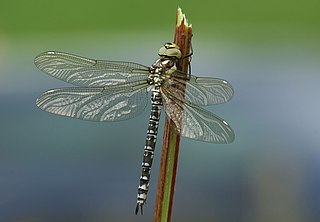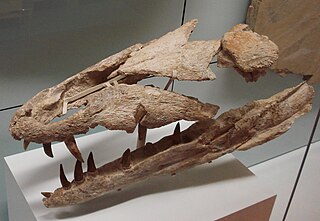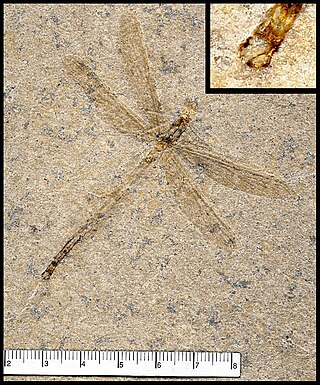
Odonata is an order of predatory flying insects that includes the dragonflies and damselflies. The two major groups are distinguished with dragonflies (Anisoptera) usually being bulkier with large compound eyes together and wings spread up or out at rest, while damselflies are usually more slender with eyes placed apart and wings folded together along body at rest. Adult odonates can land and perch, but rarely walk.

Aeshna, or the mosaic darners, is a genus of dragonflies from the family Aeshnidae. Species within this genus are generally known as "hawkers" or "darners".

Dakosaurus is an extinct genus of crocodylomorph within the family Metriorhynchidae that lived during the Late Jurassic and Early Cretaceous. It was large, with teeth that were serrated and compressed lateromedially. The genus was established by Friedrich August von Quenstedt in 1856 for an isolated tooth named Geosaurus maximus by Theodor Plieninger in 1846. Dakosaurus was a carnivore that spent much, if not all, its life out at sea. The extent of its adaptation to a marine lifestyle means that it is most likely that it mated at sea, but since no eggs or nests have been discovered that have been referred to Dakosaurus, whether it gave birth to live young at sea like dolphins and ichthyosaurs or came ashore like turtles is not known yet. The name Dakosaurus means "biter lizard", and is derived from the Greek dakos ("biter") and σαῦρος -sauros ("lizard").

Machimosaurus is an extinct genus of machimosaurid crocodyliform from the Late Jurassic and Early Cretaceous. The type species, Machimosaurus hugii, was found in Switzerland. Other fossils have been found in England, France, Germany, Portugal, Switzerland and Tunisia. Machimosaurus rex is the largest named teleosauroid and thalattosuchian, with an estimated length of up to 7.15 m (23.5 ft). Machimosaurus is the largest known crocodyliform of the Jurassic.

Epiprocta is one of the two extant suborders of the Odonata, which contains living dragonflies (Anisoptera), as well as Epiophlebioptera, which has a single known living genus Epiophlebia. Crown group Epiprocta first appeared during the Early Jurassic. It was proposed in 1992 by Heinrich Lohmann to accommodate the inclusion of the Anisozygoptera. The latter has been shown to be not a natural suborder, but rather a paraphyletic collection of lineages, so it has been combined with the previous suborder Anisoptera, the well-known dragonflies, into the Epiprocta. The old suborder Anisoptera is proposed to become an infraorder within the Epiprocta, whereas the "anisozygopterans" included here form the infraorder Epiophlebioptera. In Lohmann's original circumscription of the Epiprocta he also included the Tarsophlebiidae in it but Rehn (2003) placed it among the Zygoptera.
Paleontology or palaeontology is the study of prehistoric life forms on Earth through the examination of plant and animal fossils. This includes the study of body fossils, tracks (ichnites), burrows, cast-off parts, fossilised feces (coprolites), palynomorphs and chemical residues. Because humans have encountered fossils for millennia, paleontology has a long history both before and after becoming formalized as a science. This article records significant discoveries and events related to paleontology that occurred or were published in the year 1994.

Palaeocoma is an extinct genus of brittle stars that lived during the Middle Triassic to Early Jurassic Periods. Its fossils have been found in Europe.

The Schistes bitumineux is an Early Jurassic geologic formation in Bascharage, Luxembourg that is located within an oil shale, hence the name.

Epiophlebia is a genus of damsel-dragonfly native to the Indian subcontinent, East Asia, and Southeast Asia. It is the only living genus of Odonata to neither be a dragonfly nor a damselfly. It is the sole member of the family Epiophlebiidae, which is itself the sole living representative of the infraorder Epiophlebioptera.

Hemiphlebiidae is a family of damselflies. It contains only one extant species, the ancient greenling, native to Southern Australia and Tasmania. The fossil record of the group extends back to the Late Jurassic, making them the oldest known crown group damselflies.

The Stenophlebiidae is an extinct family of medium-sized to large fossil odonates from the Upper Jurassic and Cretaceous period that belongs to the damsel-dragonfly grade ("anisozygopteres") within the stem group of Anisoptera. They are characterized by their long and slender wings, and the transverse shape of the discoidal triangles in their wing venation.

The Tarsophlebiidae is an extinct family of medium-sized fossil odonates from the Upper Jurassic and Lower Cretaceous period of Eurasia. They are either the most basal member of the damsel-dragonfly grade ("anisozygopteres") within the stem group of Anisoptera, or the sister group of all Recent odonates. They are characterized by the basally open discoidal cell in both pairs of wings, very long legs, paddle-shaped male cerci, and a hypertrophied ovipositor in females.
Caraphlebia is an extinct genus of dragonflies, known from the Early Jurassic Mawson Formation of Antarctica. It is one of the only named fossil insects from Antarctica that have been formally described; others include two beetles, Grahamelytron crofti and Ademosynoides antarctica, both from a Jurassic deposit on Mount Flora Formation. Caraphlebia is related to the genus Liassophlebia, but the hind wing has several weak antipodals in addition to the two strong, primary ones. In 2018, Caraphlebia was confirmed to be placed in the family Selenothemistidae.
2018 in paleoentomology is a list of new fossil insect taxa that were described during the year 2018, as well as other significant discoveries and events related to paleoentomology that were scheduled to occur during the year.
2017 in paleoentomology is a list of new fossil insect taxa that were described during the year 2017, as well as other significant discoveries and events related to paleoentomology that were scheduled to occur during the year.

The Sachrang Formation or "Posidonienschiefer" Formation is a geological formation of southwestern Germany, northern Switzerland, northwestern Austria, southeast Luxembourg and the Netherlands, that spans about 3 million years during the Early Jurassic period. It is known for its detailed fossils, especially sea fauna, listed below. Composed mostly by black shale, the formation is a Lagerstätte, where fossils show exceptional preservation, with a thickness that varies from about 1 m to about 40 m on the Rhine level, being on the main quarry at Holzmaden between 5 and 14 m. Some of the preserved material has been transformed into fossil hydrocarbon Jet, specially wood remains, used for jewelry. The exceptional preservation seen on the Posidonia Shale has been studied since the late 1800s, finding that a cocktail of chemical and environmental factors let to such an impressive conservation of the marine fauna. The most common theory is the changes in the oxygen level, where the different anoxic events of the Toarcian left oxygen-depleted bottom waters, with the biota dying and falling to the bottom without any predator able to eat the dead bodies.
Rhomphaiodon is an extinct genus of prehistoric sharks in the order Synechodontiformes that has been found in Late Triassic and Early Jurassic deposits located in Europe. The type species R. minor was originally named as a species of Hybodus in 1837 by Louis Agassiz. A second species, R. nicolensis, was added when the genus was named in 1993.
This paleoentomology list records new fossil insect taxa that are to be described during the year 2022, as well as notes other significant paleoentomology discoveries and events which occurred during that year.
This list of 2023 in paleoentomology records new fossil insect taxa that are to be described during the year, as well as documents significant paleoentomology discoveries and events which occurred during that year.

Aeschnidiidae is an extinct family of Anisopteran dragonfly. Aeschnidiids were widespread and could be found on nearly every continent on Earth. They were most diverse during the Early Cretaceous before completely disappearing at the end of the Maastrichtian. Many members of this family were large dragonflies, with wing lengths ranging from 35 to 45 mm.













